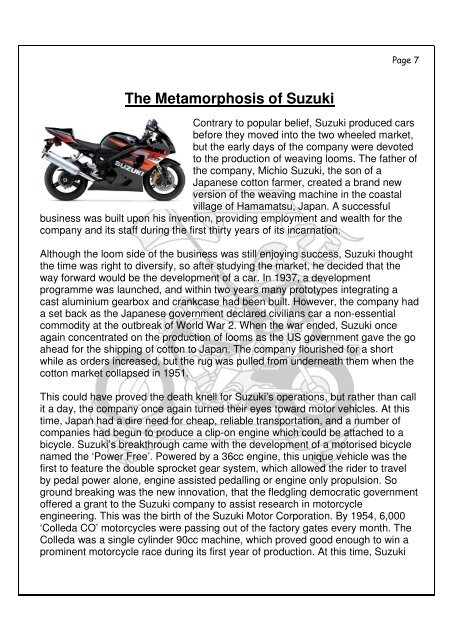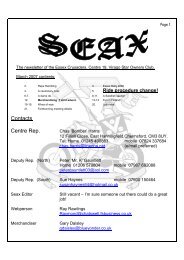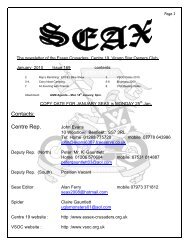SEAX - July 2009 - Essex Crusaders
SEAX - July 2009 - Essex Crusaders
SEAX - July 2009 - Essex Crusaders
Create successful ePaper yourself
Turn your PDF publications into a flip-book with our unique Google optimized e-Paper software.
Page 7<br />
The Metamorphosis of Suzuki<br />
Contrary to popular belief, Suzuki produced cars<br />
before they moved into the two wheeled market,<br />
but the early days of the company were devoted<br />
to the production of weaving looms. The father of<br />
the company, Michio Suzuki, the son of a<br />
Japanese cotton farmer, created a brand new<br />
version of the weaving machine in the coastal<br />
village of Hamamatsu, Japan. A successful<br />
business was built upon his invention, providing employment and wealth for the<br />
company and its staff during the first thirty years of its incarnation.<br />
Although the loom side of the business was still enjoying success, Suzuki thought<br />
the time was right to diversify, so after studying the market, he decided that the<br />
way forward would be the development of a car. In 1937, a development<br />
programme was launched, and within two years many prototypes integrating a<br />
cast aluminium gearbox and crankcase had been built. However, the company had<br />
a set back as the Japanese government declared civilians car a non-essential<br />
commodity at the outbreak of World War 2. When the war ended, Suzuki once<br />
again concentrated on the production of looms as the US government gave the go<br />
ahead for the shipping of cotton to Japan. The company flourished for a short<br />
while as orders increased, but the rug was pulled from underneath them when the<br />
cotton market collapsed in 1951.<br />
This could have proved the death knell for Suzuki’s operations, but rather than call<br />
it a day, the company once again turned their eyes toward motor vehicles. At this<br />
time, Japan had a dire need for cheap, reliable transportation, and a number of<br />
companies had begun to produce a clip-on engine which could be attached to a<br />
bicycle. Suzuki’s breakthrough came with the development of a motorised bicycle<br />
named the ‘Power Free’. Powered by a 36cc engine, this unique vehicle was the<br />
first to feature the double sprocket gear system, which allowed the rider to travel<br />
by pedal power alone, engine assisted pedalling or engine only propulsion. So<br />
ground breaking was the new innovation, that the fledgling democratic government<br />
offered a grant to the Suzuki company to assist research in motorcycle<br />
engineering. This was the birth of the Suzuki Motor Corporation. By 1954, 6,000<br />
‘Colleda CO’ motorcycles were passing out of the factory gates every month. The<br />
Colleda was a single cylinder 90cc machine, which proved good enough to win a<br />
prominent motorcycle race during its first year of production. At this time, Suzuki





